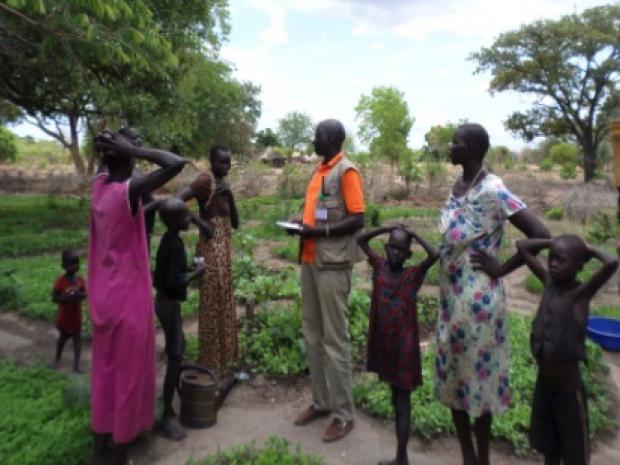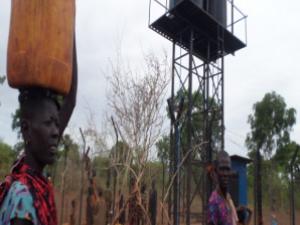The Payam Development Grant experience of LOGOSEED
The Payam Development Grant is making a difference in South Sudan
By LOGOSEED
Mary Ajok Makok, from Panloithok village, Akot Payam in Rumbek East County says water is improving the livelihoods of people in her village. The number of hours required to fetch water in Panloithok village have been reduced and women like Mary are growing vegetables using the borehole water. “We have been planting different types of vegetables such as okra, sukuma-wiki and kudra for domestic consumption. As time goes, we realized the big surplus which we sell out,” Mary adds. “The income I get from this business is used for different purposes: I pay (school) registration fees for my children and buy them stationery. I spend the rest on buying soap, salt and clothes …all these benefits are brought by this water”.

The farmers at the vegetable gardens at Panloithok
In another part of the Rumbek East, the learning environment has improved in Patir Primary School, Cueicok Payam. “The administration of this school experienced many challenges when children were learning under trees. Attendance was poor; children got distracted by outside activities; and most importantly, rains interrupted lessons,” explains Majok Kerchot, the headmaster of Patir Primary School. This problem had forced some pupils to move to other schools or abandon learning altogether. After a 50% increase in enrolment in 2016, Majok is confident that with a better learning environment the performance of children will keep improving.
These two projects that are part of the 32 implemented in 2015, demonstrate the positive impact of the Payam Development Grant (PDG) on local communities in South Sudan. The PDG is a component of the Local Governance and Service Delivery Project (LOGOSEED), a Government project financed with a credit from the World Bank and a Government of Denmark grant.
The recent release of the first tranche – 50% of the allocation – of the PDG for the 2015/16 financial year has therefore been greeted with excitement. The release will see the implementation of over 225 projects in nine counties and 31 payams. The funds amounting to SSP 132.7m will be used to drill boreholes and construct classrooms, health facilities, market sheds, storm-water dykes and access roads. In most of the payams, construction of the projects has started, while in others, mobilization of materials to commence work is at an advanced stage.

null
The PDG release was expected in September last year. At the time the controlled exchange rate regime caused concern that value for money might not be realized. An official rate of SSP 3.1SSP to 1 USD was six times lower than the parallel market rate of SSP 18 to 1 USD at the time. With the Project funds being changed at the official rate and the contractors procuring construction materials at prices determined by the parallel market rate, the projects to be implemented would have had to be drastically scaled down. The realignment of the two rates starting from late December 2015 has, therefore, enabled the Project overcome this challenge and release the funds. The second and final release for this financial year is expected in July 2016, when another PDG cycle begins for the 2016/17 financial year.
The objective of the Local Governance and Service Delivery Project for South Sudan is to improve local governance and service delivery in participating counties in South Sudan. There are four components to the project, the first component being block grants to counties for payam development. The second component is the community engagement. This component will support the engagement of citizens in the planning, implementation and oversight of local development activities at boma, payam and county levels. The component will support Government of the Republic of South Sudan (GRSS) to contract Facilitating Partners (FPs) to carry out information dissemination activities, undertake the facilitation of the planning process at boma and payam levels in an inclusive and conflict sensitive way, support communities to effectively participate in county planning processes, and support community involvement in the management and oversight of subproject implementation. The third component is the institutional strengthening. This component supports capacity building for local governments to: assume their responsibilities in the planning, implementation and oversight of local development activities including planning, budgeting, procurement, technical (engineering), environmental and social safeguards management, financial management, monitoring and evaluation functions; and to comply with the Payam Development Committee (PDG) rules and reporting requirements. Finally, the fourth component is the project management.